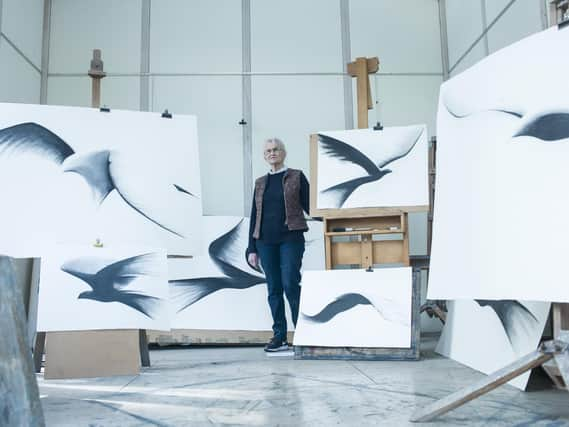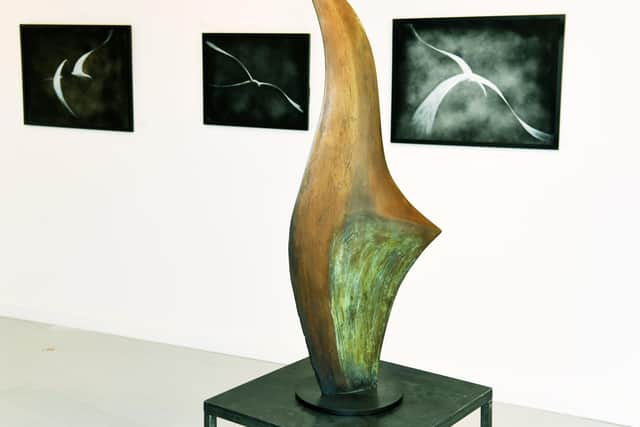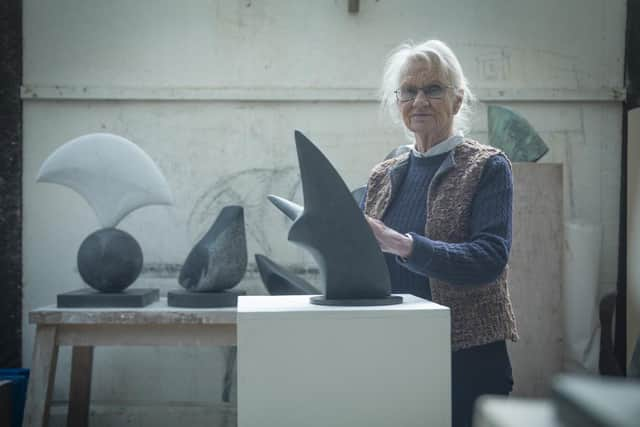Meet the acclaimed Yorkshire sculptor having her first exhibition in her home county at the age of 86


“I had this A4 book that had two little black and white photographs in it,” she says. “One was of the rams’ head capital I believe at Baalbek, and the other was of the Colossi of Memnon near Luxor and I remember at the age of five thinking ‘I want to go and see those.’”
This fascination with ancient civilizations has shaped her travels that have taken her over the decades to Africa, Europe and the Middle East and in turn, shaped her drawings and sculpture, some of which can be seen in an exhibition – The Conference of the Birds – at the new Messums gallery in Harrogate.
Advertisement
Hide AdAdvertisement
Hide AdFor Bridget, whose artworks can be found in public and private collections around the world, this is her first exhibition in her home county – at the age of 86.


Today she divides her time between Devon and Gozo in Malta, but her remarkable story began here in Yorkshire.
She was born in Horsforth, in Leeds, in 1934, but six months later the family upped sticks and moved south to follow her insurance broker father’s business. It was a sign of the peripatetic life that was to follow.
Bridget was one of more than 1.5 million children from London who were evacuated during the Blitz, ending up in Devon. It was here that she first met Elizabeth Frink, who would go on to become one of the late 20th century’s most important sculptors.
Advertisement
Hide AdAdvertisement
Hide Ad“At the beginning of the war I was sent down to live with a woman who my mother knew in Exmouth to get away from the Blitz, and a week later Liz arrived. I was six and she was aged ten. There were only 12 of us there so it was like a big family.”


After the war she and Frink struck up a friendship that continued up until the acclaimed sculptor’s death in 1993. “Liz was very supportive of my work and I used to go and see her quite a lot. She always had a Gauloises hanging out of her mouth,” she recalls with a chuckle.
Bridget trained as a painter at Farnham School of Art, where she was taught by the artist and printmaker Leszek Muszynski, in the 1950s, and it was during this period that she met Henry Moore. “A friend of mine was one of his curators and he took me to meet him.
“I remember him saying ‘do you draw’ and I said yes, because we did life drawing every day for two years when I was first at art college. And he said, ‘damn good thing too.’ It was quite scary meeting him because I hadn’t been going very long and here was this famous sculptor.”
Advertisement
Hide AdAdvertisement
Hide AdHowever, she then put her art career on hold after marrying a Royal Naval officer. “Art and the Navy don’t really mix, or they certainly didn’t in those days. But I always knew I’d get back to it.”
Her husband was captain of a minesweeper and his work took them all around the Mediterranean, which allowed her to visit some of the extraordinary places she had hitherto only read about in books. “I’d always wanted to visit different countries and I was fortunate enough to go to places like Lebanon and Cyprus, it was a magical experience.”
She took time out to raise a family (she had three daughters) and returned to her art when she was in her early 40s. It was at this point that she was introduced to two young sculptors, John Joekes and Andrea Schulewitz, who invited her to work with them. “They were based on a farm on the top of the South Downs. They were 20 years younger than me and they said, ‘why don’t you come and work with us’ and that’s what I did.”
Encouraged by her childhood friend and mentor Frink, she began to work primarily in stone and developed her own style.
Advertisement
Hide AdAdvertisement
Hide AdHer travels took her to places like Somalia, Sudan and Syria. “There used to be a camel trail that went from Khartoum up to Cairo to take the camels to market and as they stopped in the desert on the way you’d find these great rocks with drawings all over them. You can still see them 2,000 years later and I just find that fascinating because they’re not commissioned, like the temples, it’s drawings people have done and some are good and others aren’t so good.”
Forty years ago, most of these places were less volatile than they are today, though you still had to tread carefully. She travelled along the border between Ethiopia and Somalia and on one occasion was accused of being a spy because she had a camera and had been taking photographs. “I was escorted to the aeroplane so that I didn’t get arrested on the way,” she says.
Despite such scares it didn’t put her off venturing to such remote locations, and the chance to work on archaeological surveys in places like Somalia increased her interest in small objects, which continues to this day.
“The landscape around my two homes has inevitably worked itself into my mind,” she says. “The gentle curves of the hills of South Devon and the stark limestone cliffs carved by wind and sea on Gozo, have all subconsciously influenced my carving. Looking down on birds circling and gliding above their prey from my home high above the Dart estuary. They make marvellously abstracted subjects and I have carved them ever since I have been here.”
Advertisement
Hide AdAdvertisement
Hide AdBridget steadily established a reputation for her sculptures, in particular, and while she was in Somalia her husband submitted two pieces of work to the Royal Academy on her behalf that were accepted.
In her sculptures, as with her charcoal drawings, she blends the shapes associated with ancient relics, such as axe heads, with birds in flight.
Her simplified forms capture the weightlessness of the birds’ bodies suspended in mid-air. “I like to create sculptures that look as though they’re on the move because I remember being told that with sculpture you catch something when it’s not moving. And I thought ‘no, why shouldn’t I do it when it’s moving?’”
Despite her talent she doesn’t like calling herself an artist. “I think you make pieces, so I call myself a sculptor, and if you’re lucky one of them might be a work of art, but they’re not all going to be.”
Advertisement
Hide AdAdvertisement
Hide AdIn a world where just about anything can be classified as ‘art’, it’s refreshing to hear someone question that idea.
Her exhibition in Harrogate brings together examples of her recent works with some of her earlier piece and looks at how she, like Frink, found ways to break free from the restraints of artistic precision.
Bridget continues to draw and sculpt and has no intention of stopping. “I don’t work as long as I used to and I get some hefty young men to help me, but I just feel happy doing it and it helps keep me in touch with younger people, which is fun. It’s also given me a focus because you have to get on with life.”
And as for her sculptures, what of them? “I like my work to be up to date but I don’t want to be fashionable, because fashion comes and goes. So I hope my work is timeless and visually interesting enough for people to want to stop and look at it.”
Advertisement
Hide AdAdvertisement
Hide AdBridget McCrum – The Conference of the Birds runs at Messums Yorkshire, James Street, Harrogate, until October 24. The gallery is free but you need to book in advance. For more details go to messumsharrogate.com
Support The Yorkshire Post and become a subscriber today.
Your subscription will help us to continue to bring quality news to the people of Yorkshire. In return, you'll see fewer ads on site, get free access to our app and receive exclusive members-only offers.
So, please - if you can - pay for our work. Just £5 per month is the starting point. If you think that which we are trying to achieve is worth more, you can pay us what you think we are worth. By doing so, you will be investing in something that is becoming increasingly rare. Independent journalism that cares less about right and left and more about right and wrong. Journalism you can trust.
Thank you
James Mitchinson
Comment Guidelines
National World encourages reader discussion on our stories. User feedback, insights and back-and-forth exchanges add a rich layer of context to reporting. Please review our Community Guidelines before commenting.